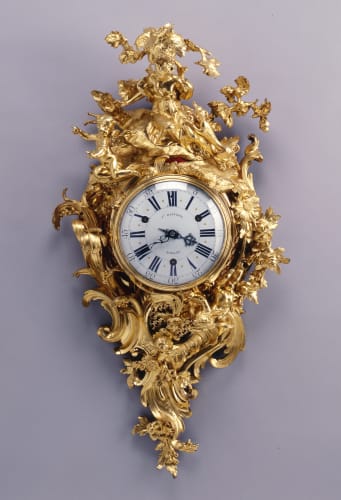John Baptiste Baillon III (d. 1772) was one of the most skilled and innovative makers of his day. Indeed Baillon achieved almost unprecedented success to become, in the words of F.J. Britten "the richest watchmaker in Europe". He was also one of the most important clockmakers of the eighteenth century and undoubtedly the most famous member of a long line of clockmakers. His success was largely due to his ability to organise a vast and thriving private factory in Saint-Germain-en-Laye which was unique in the history of eighteenth century clockmaking. Managed from 1748-57 by Jean Jodin (1715-61) it continued up until 1765 when Baillon closed it. The renowned horologist, Ferdinand Berthoud was among many to be impressed by its scale and quality and in 1753 noted that Baillon's "house is the finest and richest Clock Shop. Diamonds are used not only to decorate his Watches, but even Clocks. He has made some whose cases were small gold boxes, decorated with diamond flowers imitating nature. His house in Saint-Germain is a kind of factory. It is full of Workmen continually labouring for him…for he alone makes a large proportion of the Clocks and Watches [of Paris]". From there he supplied the most illustrious clientele, not least the French and Spanish royal family, the Garde-Meuble de la Couronne as well as distinguished members of Court and the cream of Parisian society.
Baillon's father, Jean-Baptiste II (d. 1757) a Parisian maître and his grandfather, Jean-Baptiste I from Rouen were both clockmakers, as was his own son, Jean-Baptiste IV Baillon (1752 - c.1773). Baillon himself was received as a maître-horloger in 1727. 1738 saw his first important appointment as Valet de Chambre-Horloger Ordinaire de la Reine. He was then made Premier Valet de Chambre de la Reine sometime before 1748 and subsequently Premier Valet de Chambre and Valet de Chambre-Horloger Ordinaire de la Dauphine to Marie-Antoinette, 1770. He was established appropriately at Place Dauphine by 1738 and rue Dauphine after 1751.
Due to his success, Jean-Baptiste Baillon amassed a huge fortune, valued at the time of his death, 8th April 1772 at 384,000 livres. His own collection of fine and decorative arts were auctioned on 16th June 1772, while his remaining stock, valued at 55,970 livres, was put up for sale on 23rd February 1773. The sale included 126 finished watches, totalling 31,174 livres and 127 finished watch movements at 8,732 livres. The value of his clocks totalling 14,618 livres included 86 clocks, 20 clock movements, seven marquetry clock cases, one porcelain clock case and eight bronze cases.
Today one can admire Baillon's work in some of the world's most prestigious collections including the Parisian Musées du Louvre, des Arts Décoratifs, National des Techniques, de Petit Palais and Jacquemart-André. Other examples can be found at Château de Versailles; Musée Paul Dupuy, Toulouse; the Residenz Bamberg; Neues Schloss Bayreuth; Museum für Kunsthandwerk, Frankfurt; the Residenz Munich and Schleissheim Schloss. Further collections include the Musées Royaux d'Art et d'Histoire Brussels; Patrimonio Nacional Spain; the Metropolitan Museum, New York; Newark Museum; Walters Art Gallery, Baltimore and Dalmeny House, South Queensferry.
As one of the most important makers of his day, Baillon only used the finest cases and dials. The latter were supplied by Antoine-Nicolas Martinière and Chaillou while his cases were supplied by Jean-Joseph de Saint-Germain (who also supplied him with a number of elephant and rhinoceros cases) as well as Jean-Baptiste Osmond, Balthazar Lieutaud, the Caffiéris, Vandernasse and Edmé Roy. Baillon is also known to have made some of his own models, perhaps the present example was one.
